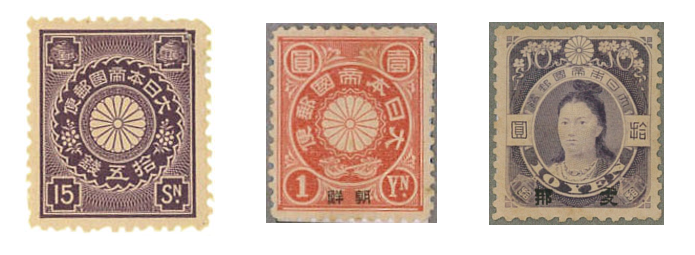歴史的背景
菊切手 1899(明治32年)ー1907(明治40年)
日本は1895年に日清戦争に勝利した。その頃、日本は明治維新以降の欧米偏重から、次第にナショナリズムに傾倒していった。1899年(明治32)、逓信省(1885年設立)は、それ迄20年以上使用された小判切手に贋造疑惑が生じ、また、製造効率向上面から新切手を発行することとした。天皇家の紋章である菊切手は、その時代を反映して英文字は除かれ、UPUの印刷色によって外国郵便の料金認識を図った。この切手には、既に統治していた清国の一部地域で流通させるため、「支那」や「朝鮮」の文字を加刷した在外地切手が1900年(明治33)より発行された。朝鮮加刷切手は、1901年(明治34)に廃止されたが、支那加刷切手は、現地で日本通貨がほぼ流通しなかったことから、1922年(大正11)まで使用された。1901年(明治34)、日本は日英同盟を締結し、日露戦争に突入することになる。
参考;小原英樹著『日本の郵便切手と近現代史抄』 2014年 P48-P52

Historical background
Chrysanthemum stamp 1899 (Meiji 32) -1907 (Meiji 40)
Japan won the Sino-Japanese War in 1895. At that time, Japan gradually became more inclined to nationalism due to the emphasis on Europe and the United States after the Meiji Restoration. In 1899 (Meiji 32), the Ministry of Communications (established in 1885) was suspected of forging stamps that had been used for more than 20 years, and decided to issue new stamps in order to improve manufacturing efficiency. The Chrysanthemum stamp, which is the emperor’s coat of arms, reflects that era, with English characters removed, and the UPU print color was used to recognize the charges for foreign mail. This stamp was issued in 1900 (Meiji 33) with the characters “China” and “Korea” printed on it in order to distribute it to some areas of the Qing dynasty that had already been governed. Korean overprint stamps were abolished in 1901 (Meiji 34), but Chinese overprint stamps were used until 1922 (Taisho 11) because Japanese currency was hardly distributed locally. In 1901 (Meiji 34), Japan signed the Anglo-Japanese Alliance and entered the Russo-Japanese War.
Reference: “Japanese Postage Stamps and Modern History” by Hideki Ohara, 2014 P48-P52
